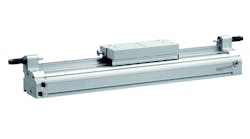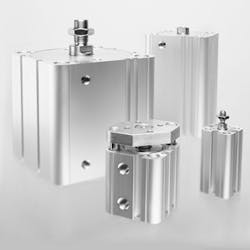How to Pick and Install the Correct Pneumatic Actuator
This file type includes high-resolution graphics and schematics when applicable.
Many industrial applications require practical and complex linear-motion systems during daily operation. No matter how complicated the system, its cost and practicality are two of the most important aspects to consider when looking at pneumatic systems and actuators. Pneumatic actuators, commonly referred to simply as air cylinders, help transfer power to useful output systems to conduct a variety of tasks.
Actuator Style: Rod vs. Rodless
These compact-style actuators can be beneficial when space limitations become a main concern.
There are two basic types of pneumatic actuator: rod and rodless style. Though rod-style actuators are the most common, many of the same selection criteria pertain to both. Rod-style actuators come in several design types and standards, which can be important to the user because the envelope dimension of a cylinder is typically consistent throughout. Most cylinder designs will adhere to a standard set forth by organizations such as the National Fluid Power Association (NFPA) or International Standards Organization (ISO).
Rod-style actuators include:
• Round repairable – No design standard
• Round non-repairable – No design standard
• Round design – Metric ISO, repairable
• Compact design – Metric ISO/non-ISO, repairable
• Tie-rod design – NFPA interchangeable industrial type, inch and non-NFPA, repairable
• Tie-rod design – Non-NFPA, repairable
• Tie-rod design – Metric ISO, repairable
• Profile design – Metric ISO, repairable
• Round design – Metric ISO, repairable
• Slide and gantry design
Rodless-type actuators are also available in different design styles. A large benefit of the rodless-type actuator is that it saves up to 50% of weight and space when compared with the rod style. The downside to rodless-style actuators is that they are limited when it comes to mounting.
Rodless-style actuators include:
• Single profile barrel and cartridge design – Inch and metric
• Single profile barrel and cartridge with external bearing rail design – Inch and metric
• Magnetically coupled single barrel design – Metric
• Magnetically coupled external guide design – Metric
Several important factors should be taken into account when selecting the correct actuator for the application. Once the designer completes the application assessment, selecting the proper cylinder is much easier as the actuator successfully performs its intended functions. Most cylinder manufacturers offer online configurators that can assist in the selection process. However, inputting the proper information is something that should be considered because of how the cylinder is sized.
Selecting a Cylinder
It is necessary to know the following design parameters before selecting a cylinder. This checklist presents considerations to weigh when contemplating an actuator:
• Analyze the application
- Will this be cylinder be new or replacement? If replacing, why did the actuator fail?
• Force required
- How much force will be required for extension and retraction?
• Actuator stroke
• Actuator speed
• Are there space constraints?
- If yes, it might be a good idea to consider compact rodless actuators.
• Air pressure available
- It is advisable not to size the actuator based on the pressure provided, but 85%-90% of that value is a safety factor.
• Mounting angle of actuator
• Mounting style
- Fixed or pivot?
- Once that is determined, the appropriate mounting can be selected.
• Required life of the actuator
- Repairable vs. non-repairable
• Will cushions or bumpers be required?
- This is based on the load and speed that the actuator will encounter.
• Is the actuator subject to side load?
- If yes, how much force is the side loading?
• Long-stroke actuators may require internal “stop tube” or trunnion mounting that provides additional bearing support.
• Environment
- Special paint or stainless-steel construction may be required.
• Sensing piston-rod position (head, cap end, or both; entire piston travel); the actuator will need to be manufactured with a magnetic ring on the piston.
• Are multiple fixed positions needed?
- If yes, multiple fixed positions can be obtained.
Rod-style actuators, like the one seen above, are the most common type of actuator. They come in many standard configurations.
If you are the application designer or maintenance person responsible for sizing, selecting, or replacing the actuator, then answers to these questions will ensure the correct actuator is selected for the application. If it is simply an actuator replacement, then the question that needs to be asked is: “Did the actuator provide reasonable life for the particular application, or did it require service or replacement sooner than expected?”
If reasonable life was achieved, then a simple repair or like replacement based on cost should continue to be successful. However, if the actuator is not delivering the life expectancy, then it is probably the wrong actuator for the application.
A worn cylinder can provide information as to a possible cause of failure. For example, a warn rod bearing on one side or broken rod end threads would indicate side loading. Therefore, a different mounting style or guided actuator would be a more appropriate solution.
Proper filtration should be used to maximize seal life. When using inline lubricators, make sure the oil is compatible with the seal material. Keep in mind that some synthetic oils are not compatible, so mineral-based oil should be considered. Many designers are looking for lighter-weight actuators than heavy steel-constructed actuators. If that is the case, an aluminum profile actuator is a good alternative, as it can still operate in demanding applications.
Properly adjusted cushions at the head (rod end) and cap (blind end) can extend the life of not only the actuator, but also the machine framework, by reducing shock in demanding applications where speed and load are a major factor. Manufacturers have computer programs that can aid in determining if the internal cushions are adequate to dissipate the energy, and if not, it may require mounting shock absorbers on the machine frame.
Long-stroke actuators that require pivot mounting should consider either intermediate trunnion mounts that can be positioned anywhere along the actuator’s barrel, or head trunnion mounts to shorten the fulcrum point of the actuator mount and the load attached to the end of the rod. Some long-stroke applications may need a trunnion mount as well as an internal stop tube for additional internal bearing support.
Benefit Summary
Rodless actuators offer the benefits of reduced weight and a smaller profile. They also have the ability to counteract offset loads.
Rodless actuators offer a reduced weight and smaller overall profile compared to the rod-style actuator. The rodless-style actuator has the added benefit of guide bearing to counteract offset loads. A disadvantage would be the fixed mounting or lack of pivot. However, with some modification, its mounting plate could be made to pivot.
Most rodless cylinders, regardless of manufacture, have a slight leak path due to the piston/cartridge assembly. As a result, they are not the best for load holding applications. Air-bellow actuators are a good option for applications that require a low profile plus high force capability with the ability to arc to the required position.
Air actuators can be a cost-effective way to achieve the desired force or work, with the key being proper sizing and reducing the air pressure required to perform that work. Often times, only one direction of travel is performing the work and the return direction is idle. Therefore, dual pressure adds to the efficiency of the system.
Bill Nevills is Certified Fluid Power Specialist for Valin Corp. Visit www.valin.com for more information about the company.





